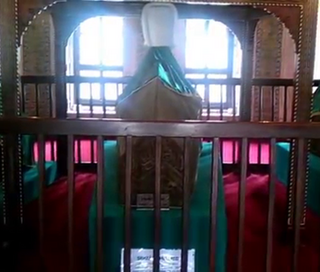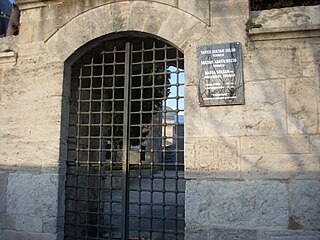
Rumelihisarı or Boğazkesen Fortress is a medieval Ottoman fortress located in Istanbul, Turkey, on a series of hills on the European banks of the Bosphorus. The fortress also lends its name to the immediate neighborhood around it in the city's Sarıyer district.

The Fatih Sultan Mehmet Bridge, also known as the Second Bosphorus Bridge, is a bridge in Istanbul, Turkey spanning the Bosphorus strait. When completed in 1988, it was the 5th-longest suspension bridge span in the world.

Fatih is a municipality and district of Istanbul Province, Turkey. Its area is 15 km2, and its population is 368,227 (2022). It is home to almost all of the provincial authorities but not the courthouse. It encompasses the historical peninsula, coinciding with old Constantinople. In 2009, the district of Eminönü, which had been a separate municipality located at the tip of the peninsula, was once again remerged into Fatih because of its small population. Fatih is bordered by the Golden Horn to the north and the Sea of Marmara to the south, while the Western border is demarked by the Theodosian wall and the east by the Bosphorus Strait.

A drillship is a merchant vessel designed for use in exploratory offshore drilling of new oil and gas wells or for scientific drilling purposes. In recent years the vessels have been used in deepwater and ultra-deepwater applications, equipped with the latest and most advanced dynamic positioning systems.
Hoca Sadeddin Efendi was an Ottoman Islamic scholar, theologian, official, and historian, a teacher of the future Ottoman sultan Murad III. His name may be transcribed variously, e.g. Sa'd ad-Din, Sa'd al-Din, Sa'düddin, or others. He was also called by the title of "Câmi'-ür Riyâseteyn".

Kahramankazan is a municipality and district of Ankara Province, Turkey. Its area is 547 km2, and its population is 59,123 (2022). It lies in the plain of Akıncı to the north west of the city of Ankara. Its elevation is 892 m (2,927 ft).
Ocean Rig UDW Inc. was an operator of semi-submersible oil platforms and underwater drillships and was based in Athens. In 2018, the company was acquired by Transocean.

Türkiye Petrolleri Anonim Ortaklığı (TPAO) was founded in 1954 by Law No. 6327 with the responsibility of being involved in hydrocarbon exploration, drilling, production, refinery and marketing activities of oil and gas in Turkey as the national company.

The Yavuz Sultan Selim Bridge, also known as the Third Bosphorus Bridge, is a vehicular bridge over the Bosphorus strait, to the north of Istanbuls's two older suspension bridges, the 15 July Martyrs Bridge being the First Bosphorus Bridge and Fatih Sultan Mehmet Bridge the Second Bosphorus Bridge. The bridge is located near the entrance to the Black Sea from the Bosphorus strait, between Garipçe in Sarıyer on the European side and Poyrazköy in Beykoz on the Asian side.
Yavuz is a common masculine Turkish given name and in Turkish, "Yavuz" means "inflexible", "resolute" and "ferocious".

Piri Mehmed Pasha was an Ottoman statesman, and grand vizier of the Ottoman Empire from 1518 to 1523.

Şehzade Mehmed was an Ottoman prince (şehzade), the son of Sultan Suleiman the Magnificent and his wife Hurrem Sultan. He served as governor of Manisa.

Beyhan Sultan, also known as Peykhan Sultan, was an Ottoman princess, daughter of Selim I and probably Ayşe Hafsa Sultan. She was the sister of Sultan Suleiman the Magnificent.

Edirne Palace, or formerly New Imperial Palace is a former palace of the Ottoman sultans in Edirne, built during the era when the city was the capital of the empire. Few of the palace buildings have survived until now, however reconstruction works are underway.

Selim I, known as Selim the Grim or Selim the Resolute, was the sultan of the Ottoman Empire from 1512 to 1520. Despite lasting only eight years, his reign is notable for the enormous expansion of the Empire, particularly his conquest between 1516 and 1517 of the entire Mamluk Sultanate of Egypt, which included all of the Levant, Hejaz, Tihamah and Egypt itself. On the eve of his death in 1520, the Ottoman Empire spanned about 3.4 million km2 (1.3 million sq mi), having grown by seventy percent during Selim's reign.
Fatih, ex Deepsea Metro II, is a Turkey-flagged sixth generation ultra deepwater drillship owned and operated by the state-owned Turkish Petroleum Corporation (TPAO). She is Turkey's first drillship.

Kanuni is a Turkey-flagged sixth-generation ultra deepwater drillship owned and operated by the Turkish Petroleum Corporation. She is Turkey's third drillship.
Abdülhamid Han is a Turkey-flagged seventh-generation ultra deepwater drillship owned and operated by the Turkish Petroleum Corporation. She is Turkey's fourth drillship.
Zenbilli Ali Cemali Efendi Ottoman mufti, Islamic scholar (alim), shaykh al-Islam, Sufi, and minister. Zenbilli Ali was the son of Ahmed Çelebi, the grandson of Cemaleddin Aksarayi, a descendant of Fahraddin al-Razi. Since he is the descendant of Cemaleddin Aksarâyî, he is referred to with the title of Cemali, like his contemporary relatives and other statesmen and scholars. He was known among the people as "Zenbilli mufti" and "Zenbilli Ali Efendi", because he took people's questions with a weaved basket (zenbil) hanging from the window of his house in order to conclude the affairs of those who applied to him for a fatwa in a short time and put the answers back in the zenbil.













